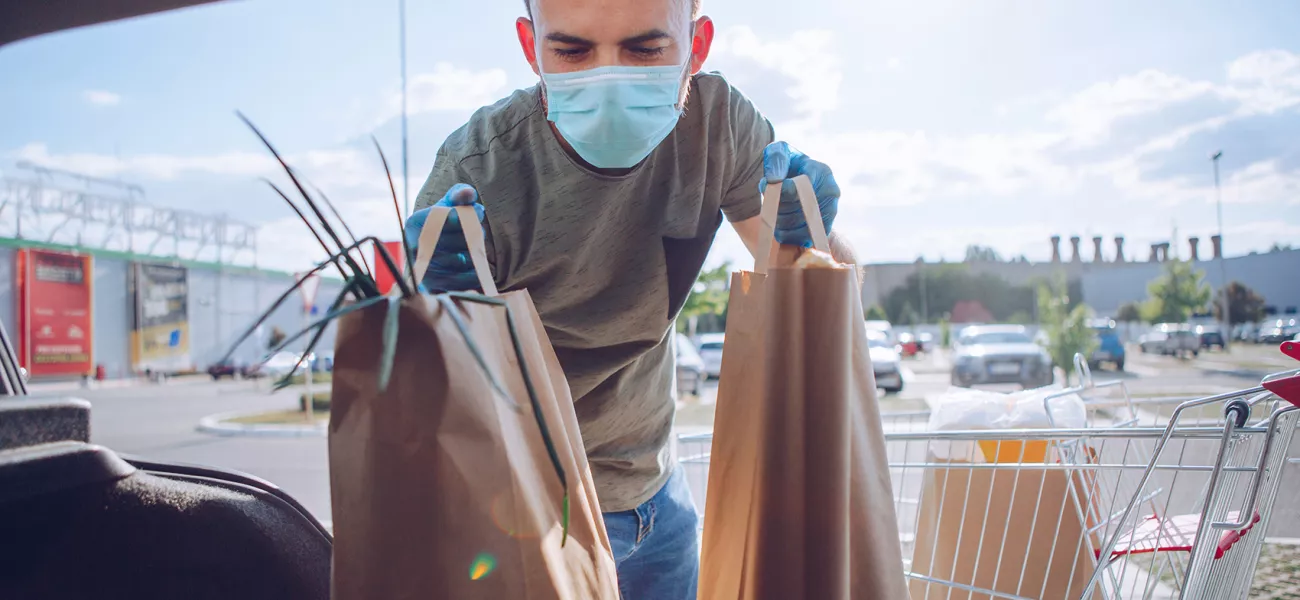
How has the retail industry been impacted since the pandemic hit? How have companies tried to adapt and evolve to meet today’s challenges? Two of Axis’ industry experts answer these questions and discuss how network technology is and will continue to play a pivotal role in the retail industry now and post-pandemic.
Many retailers today serve their customers through an omnichannel approach. This encompasses everything needed to provide a seamless experience for customers regardless of their manner of shopping. Whether they shop via e-commerce using a mobile device or laptop, by phone, or in-person at a store, consumers expect their shopping experience to be integrated and whole.
The COVID-19 health crisis has accelerated some shopping behaviors and caused them to grow at a faster-than-normal pace—and it’s easy to see how. For example, look at the surge in buy online pick up in store (BOPIS) or curbside pickup. General merchandise retailer Target recorded more than 700 percent growth in curbside pickup in the second quarter of 2020, compared with the same period in 2019. [i]
Safety and security requirements in the retail sector have become more complex as a result of COVID-19-related restrictions on indoor shopping, as well as the rapid expansion of BOPIS shopping. This is especially true for nationwide retail chains, which currently face a multitude of different COVID-19 restrictions that vary by locale.
COVID-19 has caused retailers to want to implement network technology at an accelerated pace. In mid-2020 the industry buzzed with talk about solutions that could depict occupancy levels in stores, check shoppers’ compliance with wearing masks, and detect elevated skin temperature for indication of a person with a fever. But Hedgie Bartol, segment development manager–retail, Axis Communications, Inc. says that’s putting the cart before the horse per se.
“Retailers started to move in that direction and quickly realized that technology in and of itself was not the answer,” Bartol explains. “They should really be relying on what I call the three Ps—people, process, and procedures—to solve their problems first; and then, how can technology augment what they’ve implemented with people, process, and procedures?”
The reason it is so important for retailers to keep the focus on the three Ps is because technology cannot take the place of any of those pillars of safety and security. Rather, technology is a tool that supports and enhances them. For that reason, choosing the right network technology should be done with a holistic plan and a long-term view.
The long-term plan: Technology for today and tomorrow

Retailers quickly realized they can’t just implement a technology in a knee-jerk fashion to address the health crisis today, and today only. Rather, they have to take more of a long-term approach to how technology can be used in the future for business operations. “If we were to implement very expensive thermal camera systems for our core body temperature, and then in a year, when COVID is hopefully no longer an issue, what do we do with that technology?” Bartol suggests retailers ask themselves.
The life-cycle of a security system needs to outlive the health crisis, ideally still proving itself beneficial for up to 10 years, Bartol says. This makes it prudent for managers to consider how any technology will serve their business in both the short-term and long-term.
One example of that concept is curbside pickup, which moves employees outside of the protected premises perhaps for the first time. A retailer might now consider using body-worn cameras, such as those from Axis, to not only aid in the safety of the individual delivering the merchandise, but to record the sold merchandise and the action of placing it in the customer’s vehicle. Curbside pickup is not expected to wane following the pandemic, so retailers also should consider implementing technology that alerts when the expected vehicle arrives at curbside, such as license plate recognition solutions.
As safety practices evolve in the post-pandemic world, the planning for technology also will evolve, and the needs of stakeholders will change. For example, video platforms have played a strategic part in many businesses that have had to shut their doors during the pandemic.
Managers relied on the capabilities of remote video to watch their stores while they remained closed. At stores that remained open, remote video was a crucial tool for managers who weren’t able to actually be present due to travel restrictions.
"Retailers should be relying on what I call the three Ps—people, process, and procedures—to solve their problems first,” says Bartol.
It was beneficial “not just for loss prevention, but now for real estate, to make sure things were looking good; for marketing to make sure that the new merchandising material was there; for observing staffing and being able to do health and safety audits,” says Rick Snook, business development manager Canada – retail & banking, Axis Communications, Inc.
Their network video systems gave retailers a total visual overview, also allowing them to check their stores in preparation of reopening.
“Was there looting that went on? Was there damage to the facility? Did they have leaks? It was also part of insurance requirements to have visual visits to the premises every 24, 48, or 72 hours—whatever that underwritten policy is—using remote video,” Snook continues.
The evolving role of health & safety teams
One stakeholder in particular that has discovered the benefits of network security technology are retail health and safety teams. Historically, these teams have focused on OSHA-related matters and the overall health and well-being of a store’s associates and customers.
Prior to the health crisis they generally reported to the risk side of a retail business rather than to loss prevention. But what you’ve seen over the past several months is a much greater interaction between health and safety and risk and loss prevention, something Bartol believes will continue post-pandemic.
“By their nature, loss prevention teams are problem-solvers,” Bartol explains. “The two business units have become much more closely entwined and engaged because they had to work together to develop and implement the processes and procedures for how to move forward. They relied very heavily on one another’s skill sets for addressing the COVID-19 situation.”
Effective communication needs to evolve from being a siloed approach to a roundtable of stakeholders.
“People in loss prevention/asset protection need to be able to tell people in health and safety—if they’re not one and the same—how technology can help them,” Snook continues. “But health and safety needs to say, ‘This is what I’m dealing with, and I’ve got a high rate of circumstance; is there a way to automate this?’ Working together, it builds a solution.”
The term “meaningful output” is one that Snook uses in reference to businesses that review how network security technology can make their businesses stronger and more efficient.
“When I use some form of technology, it’s giving me information that’s meaningful to make changes to the way I do business, or creates a customer journey, or gives me information that helps me reduce my shrink or increase my customer service and salability,” Snook explains.
“It’s prudent for managers to consider how any technology will serve their business in both the short-term and long-term.”
Security technology should afford three things to a business, Snook advises: “It must provide meaningful output, be scalable, and have longevity in that it produces a solution for the core issue of a problem. I think if you get those three factors, you’re there.”
The future of network systems is with edge processing, analytics, and the cloud

Retail managers who bring insights to their business will want to be knowledgeable about trends in network security solutions and what is expected. Three major trends are edge processing, cloud-based solutions, and artificial intelligence.
“You’re going to see more and more intelligence and capability being put at the edge—the device at the very end of the network,” Bartol says.
In the case of security, this could be network cameras, network speakers, or other sensors or receivers. This allows the devices to do more analysis and make decisions and perform tasks onboard the camera, instead of having to go to a server.
In addition, Bartol believes the pandemic has revealed the power of cloud-based solutions. The health crisis provoked a need to move quickly and adjust on the fly, which is difficult to do if you have to touch every single retail location. “With the advent of cloud-based solutions, to be able to implement and roll out an analytic or a new technology via the cloud, it can have tremendous benefit, especially in the environment that we’re currently in,” Bartol notes.
These trends combined will allow for greater processing and greater utilization of artificial intelligence. They will benefit loss prevention professionals by giving them more information in a more efficient manner because you’re not necessarily sending large packets of video data through the cloud anymore; you’re sending the metadata that allows for analysis of what’s happening in the store and it creates the ability to have an event-to-action.
Snook says edge processing holds great excitement, “but the one important thing in the journey for all of us as manufacturers, as integrators, and as end customers is communication.
That is looking at the needs as they change for the business, and adapting technology to fit the needs of the business,” Snook says.
He maintains that retail is one of the most dynamic sectors of business, and providers need to listen carefully to meet the technology needs of this changing environment, “to make sure that the customer experience is right.”
“Security technology should provide meaningful output, be scalable and have longevity,” says Snook.
The current health crisis brings an intense focus on what retailers can do to stay open for business. But each decision you make about technology today creates your store’s future environment, which will endure well beyond the pandemic. Keeping in mind the type of experience you’d like to ultimately provide to your customers can help you choose network solutions based on sight, sound, and analytics that offer security and business intelligence efficiently and effectively.
[i] “Curbside pickup powered by MFCs driving growth in grocery e-commerce,” Supermarket News, last modified December 18, 2020, https://www.supermarketnews.com/technology/curbside-pickup-powered-mfcs-driving-growth-grocery-e-commerce
